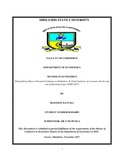Please use this identifier to cite or link to this item:
https://cris.library.msu.ac.zw//handle/11408/3980Full metadata record
| DC Field | Value | Language |
|---|---|---|
| dc.contributor.author | Katuka, Blessing | - |
| dc.date.accessioned | 2020-12-09T09:02:09Z | - |
| dc.date.available | 2020-12-09T09:02:09Z | - |
| dc.date.issued | 2017-11 | - |
| dc.identifier.uri | http://hdl.handle.net/11408/3980 | - |
| dc.description.abstract | This study investigated the determinants of non-performing loans as well as demystifying macrofinancial linkages in Zimbabwe using a panel of nine banks and semi-annually decomposed data from 2009 to 2017. A combination of panel regressions techniques and panel VAR analysis was employed to meet research objectives. Findings revealed that growth in non-performing loans is driven by both bank-specific and macroeconomic factors in Zimbabwe. Findings confirmed that the main drivers of nonperforming loans in Zimbabwe are loan-to-deposit ratio, equity-to-assets ratio, loans-to-assets ratio and capital inflows and one-period lagged non-performing loans ratio. Findings suggested positive association between the loans to assets ratio and non-performing loans and this supports the moral hazard hypothesis which stipulates that high loans to assets ratio results in the growth of NPLs. The study uncovered the presence of feedback effects from banking sector to the real economy and spill-over effects from real economy to the banking sector. Orthogonalized impulse response function results showed that non-performing respond positively in the short run and negatively in the long run to an innovation in lending rates, real GDP growth rate and capital inflows growth whereas response of non-performing loans to own shock is negative both in the short run and in the long run. Findings indicated that shock in lending rate initially results in a short-lived rise in real GDP growth rate and then a decline in real GDP growth rate in the later stage of the short run period and the decrease continues into the entire long run period. Undoubtedly, the researcher recommends authorities to maintain interest rate capping policy in order to ensure reduction in non-performing loans in the long run. Monitoring of lending rates through capping policy is also of paramount importance since the study uncovered that lending rates adversely affects real GDP growth rate and capital inflows in the long run. Furthermore, policy implications of this study would be that banks must strengthen the loan origination process so that high loan-to-assets do not necessarily translate to high non-performing loans. | en_US |
| dc.language.iso | en | en_US |
| dc.publisher | Midlands State University | en_US |
| dc.subject | macro-financial linkages | en_US |
| dc.subject | analysis of economic shocks | en_US |
| dc.subject | non-performing loans | en_US |
| dc.title | Demystifying macro-financial linkages in Zimbabwe: a panel analysis of economic shocks and non-performing loans (2009-2017) | en_US |
| dc.type | Thesis | en_US |
| item.grantfulltext | open | - |
| item.languageiso639-1 | en | - |
| item.openairetype | Thesis | - |
| item.fulltext | With Fulltext | - |
| item.openairecristype | http://purl.org/coar/resource_type/c_18cf | - |
| item.cerifentitytype | Publications | - |
| Appears in Collections: | Master Of Commerce In Economics Degree | |
Files in This Item:
| File | Description | Size | Format | |
|---|---|---|---|---|
| First Draft-Reviewed Original - Final-To print.pdf | Full Text | 1.73 MB | Adobe PDF |  View/Open |
Page view(s)
280
checked on Jan 10, 2026
Download(s)
208
checked on Jan 10, 2026
Google ScholarTM
Check
Items in MSUIR are protected by copyright, with all rights reserved, unless otherwise indicated.



